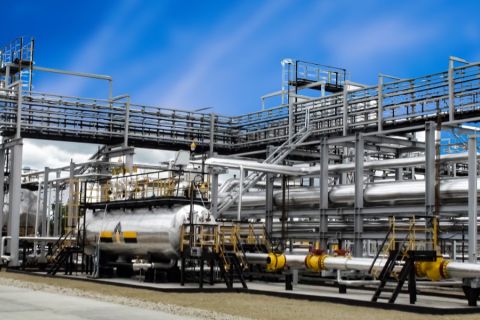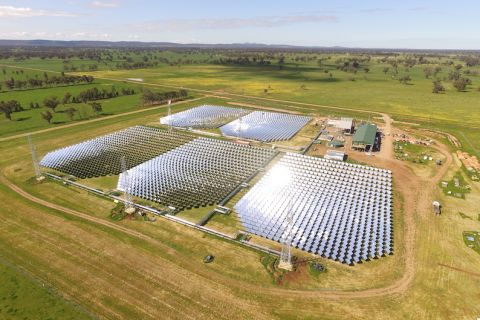Billions of dollars will be spent in southwestern Wyoming's Wamsutter area during the next several years to recover hundreds of billions of cubic feet of natural gas. A giant gas play is in full swing in the eastern part of Wyoming's Washakie Basin. The Wamsutter area, in Carbon and Sweetwater counties, is buzzing with activity. And what's surprising is that the lead operator is a multinational oil company. Last fall, London-based BP announced that it would spend $2.2 billion in the Wamsutter area. BP plans to drill 2,000 wells during the next 15 years, and by the end of the decade expects to double its net Wamsutter production from 125- to 250 million cubic feet of gas per day. The drilling program will add 450 million barrels of oil equivalent to BP's reserves. Preparations for this dramatic program have been in the works for some time. Several years ago, BP began focusing attention on the sprawling area. Wamsutter had been producing gas from Upper Cretaceous reservoirs for decades, but the gigantic size of its potential resource base had yet to be appreciated. Indeed, Wamsutter is now recognized as one of the largest tight-gas-sand accumulations in the U.S. The area, which covers an astonishing 1,700 square miles, is already home to some 2,000 wells that have produced more than 2 trillion cubic feet of gas. And trillions more will be produced in the future as thousands of locations are drilled and placed onstream. In 1969, Amoco (which was acquired by BP in 1998) signed a 35-year drill-to-earn agreement that covered portions of the Union Pacific Railroad land grant. The farm-out Amoco negotiated allowed it to earn a 75% working interest in each section of land-grant acreage in which it established commercial natural gas production. The land grant dates back to 1862, when Congress passed legislation to promote construction of the transcontinental railroad. The Union Pacific and Central Pacific railroads were granted 400-foot rights of way, plus 20 square miles of land for every mile of track built. The land was awarded as odd-numbered sections for 20 miles on either side of the tracks. Houston-based Anadarko Petroleum Corp. acquired the land-grant acreage in 2000 when it purchased Union Pacific Resources. The checkerboard acreage, all fee, spans nearly 700 miles in southern Wyoming and portions of northeast Colorado and Utah. As the land-grant farm-out neared the end of its term, BP launched an aggressive drilling program to capture acreage. During the final years of the agreement, BP drilled some 300 wells in the Wamsutter area. Simultaneously, the major obtained a revision of the field-wide rules for the Wamsutter development area, allowing wells to be drilled on 80-acre densities rather than the 160-acre densities previously authorized. At present, BP has 950 producing wells and 352,000 leased acres in the Wamsutter area. "This is the largest contiguous field that BP owns in the Lower 48," says Marti Gazzier, Houston-based government and public affairs director. BP is currently running seven to eight rigs in the field, and has additional rigs on order. A major program Once BP committed to the multi-year Wamsutter project, it earmarked massive amounts of capital and resources to see it to fulfillment. In addition to standard development drilling, BP plans a field trial program to test new technologies, including improvements in drilling techniques and rig designs. Reducing the development footprint is a huge area of interest. BP is testing deviated drilling and multi-well surface facilities, such as eight-well pads with common separators and tanks, to limit surface disturbances. The company is also making a commitment that is quite unusual in the Lower 48. Because the project life spans more than decade, the area is remote, and the climate is difficult, BP is building a Wamsutter base camp in the eponymous town. The little town of Wamsutter has struggled throughout most of its 130 years of existence, its fortunes tied to the comings and goings of railroads, ranches, uranium mines, oil wells and most recently, natural gas development. At the moment, it's a windy, ramshackle collection of trailers and industrial buildings that sits astride Interstate 80. "Wamsutter is a community of about 500 people, and it's not set up yet for the kind of housing and infrastructure that is needed," says Gazzier. Hundreds of workers commute each day to the area from the larger communities of Rawlins, 40 miles east, and Rock Springs, 70 miles west, and scores more are housed in temporary trailer camps set up by oilfield companies in and around the town. BP is constructing a $6-million, 40,000-square-foot base camp that will house up to 400 people and provide better living situations for its workers. The camp features such amenities as private rooms and a recreation center. "We have all the comforts of home. It's very state-of-the-art." Across the road, BP is also building a $6-million office facility. The major is also working to improve infrastructure in the sparsely populated area. "We are providing seed money for Wamsutter for such things as sewers, daycare needs and law enforcement," she says. One telling advantage that BP wields is that the size and scope of its program, and its fee-land position, give it considerable flexibility in arranging long-term service and supply contracts to develop the acreage. "We are out of the cyclical swings in the business, and we have a sturdy momentum going forward," says Gazzier. Independent position Independent Anadarko Petroleum has an extensive position in Wamsutter as well. Anadarko is a 25%-working-interest partner in the sections BP earned through the land-grant farm-out, and it also owns the royalty interests on that acreage. Additionally, the company has land-grant acreage that was not earned in the farm-out, and holds substantial additional acreage in federal and state leases. "Of the entire greater Wamsutter area, the combination of BP and Anadarko control about 60% of the acreage, and we have one-third of that," says Mark Bacon, The Woodlands, Texas-based engineering advisor. Anadarko makes 95 million net cubic feet of gas each day from the Wamsutter area. In addition to its slice of the BP activity, the independent operates 160 wells and runs a rig in the play. "We've had one rig for the past four years, and we're adding another one in the last quarter of this year." The addition of the second rig will enable Anadarko to drill close to 50 wells a year. Its well costs have been rising, but at present run from $1.4- to $1.8 million apiece. Depth, number of frac stages, and vertical or directional drilling all impact total costs; Anadarko typically fracs three stages per well. The average Wamsutter well drilled today recovers between 1- and 2 billion cubic feet equivalent (Bcfe), but the distribution is significant, ranging from 100 million to 3 Bcfe, says Bacon. Obviously, these recoveries are significantly less than operators enjoyed in the past, when monster wells in areas like Standard Draw produced more than 20 Bcfe. That's because those big wells were drilled into a marine bar sequence that had high permeabilities, high volumes of gas in place and high recoveries. "Those reservoirs are substantially depleted at this time. Most of the new reserves come out of fluvial or middle-marine intervals that aren't as well connected." Indeed, depleted zones contribute to drilling and completion risks in the Wamsutter area, although for the most part operations are straightforward. "Occasionally we can lose circulation, but historically this has not been a difficult area to drill." Still, Anadarko pays close attention to well costs and efficiencies: "We're getting to the point in the field where we are attacking smaller reserve numbers, so it's very important to do everything right." Anadarko has a long-term inventory, and expects to be busy in Wamsutter for years to come. In the conventional Wamsutter area, somewhere north of 5,000 wells could still be drilled, assuming some combination of 80- and 40-acre densities. "We're only part way into 80s at this time, and it's premature to assume that 40s will be drilled, although at today's gas prices that seems reasonable." The possibility of eventual downspacing to 40s is one of the factors that Anadarko considers in drilling directional wells from pads, even in areas where that is not required. "We're developing the technology for the future. With everything we know today, development in Wamsutter could last from another five to as long as 20 years." Low costs Another principal operator in Wamsutter is Oklahoma City-based Devon Energy Corp. The independent has been involved in Wamsutter since 2000, and at present holds more than 200,000 acres in the heart of the play, mainly in federal leases. "We currently operate more than 400 producing wells, and we make 115 million gross cubic feet per day from the Wamsutter area," says Don DeCarlo, vice president and general manager, western division. Devon was running six rigs in early 2006, and expected to spend more than $100 million a year for the next decade. "We have a large inventory and a brisk development phase going forward." Devon's wells average about $2 million apiece, and are usually completed with four to five frac stages. Each frac stage uses up to 250,000 pounds of sand, says DeCarlo. Per-well recoveries can vary quite a bit, but Devon's wells are around 1.5 Bcfe each. That results in attractive finding and development costs ranging from $1.25 to $1.50 per thousand cubic feet. "We certainly do not need $10 gas to drill this play; we've been developing out here for many years in a substantially lower price environment," he says. Devon expects to drill 60 to 80 wells a year for the next several years. But because it operates primarily on federal lands, the company is constrained to seven- to eight-month drilling seasons. "Between April and July of each year we are basically shut down due to federal lease stipulations." The good news is that there is plenty of gas in Wamsutter; the challenge, says DeCarlo, is bottlenecks that the company faces at most every turn. The Rockies can be a difficult place to work, because of weather conditions, labor, environmental and regulatory issues, and pipeline constraints. And activity is very high. "Nobody has plenty of pipe, plenty of wellheads and flanges, or plenty of anything right now. We're picking up our drilling pace, but we're picking up at a moderate level." Looming over Wamsutter are issues with federal drilling permits. In some areas, the numbers of wells have reached limits approved previously by the regulators and permits for new locations are in hiatus. A draft Environmental Impact Statement is in the works, but completion is years away. In the interim, Devon plans to mount a reasonable development program: it has an inventory of permits and it believes that it will be able to drill new wells off existing pads. Remediation of old wellsites might provide another avenue of activity. One keen shortage dogging all the operators is a lack of quality workers. The company has several initiatives to address this problem. Devon pays bottomhole incentives to rig crews for wells that are completed within certain parameters and it helps fund a program in Wyoming to train new oilfield employees. It has also ordered several new-generation rigs that are safer and more efficient than existing ones. "The new rigs attract the best talent, because the guys are effectively working inside, and this is a very tough environment." Despite the obstacles, and to the surprise of many, Wamsutter has quickly become one of the cardinal areas for natural gas development in the onshore U.S. "We've had demonstrable production growth during the past several years, and there is enough inventory going forward to fuel additional growth," says DeCarlo. "The resource is definitely there."
Recommended Reading
Markman: Want CO2 Gone Now? Well, You Don’t Always Get What You Want
2024-04-29 - A slew of scenarios shows that climate goals can be achieved with the use of fossil fuels and CCUS.
Renewable Energy Producers Prep for More Demand from Big Tech
2024-05-07 - Dominion Energy expects to connect 15 more data centers this year.
Could Concentrated Solar Power Be an Energy Storage Gamechanger?
2024-03-27 - Vast Energy CEO Craig Wood shares insight on concentrated solar power and its role in energy storage and green fuels.
Amid ‘Battery Arms Race,’ Xerion CEO Talks Tech, Maturing Market, China
2024-04-10 - The late-stage battery startup is active in the military and electronics space, but is gaining attention for technology that extracts lithium from geothermal brine.
US Geothermal Sector Gears Up for Commercial Liftoff
2024-04-17 - Experts from the U.S. Department of Energy discuss geothermal energy’s potential following the release of the liftoff report.





